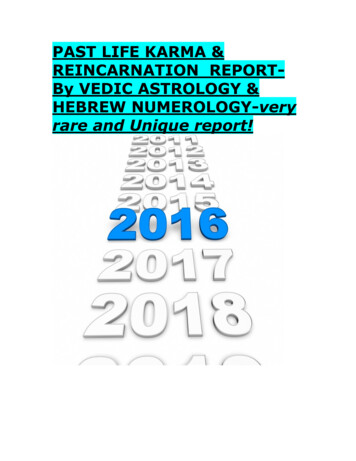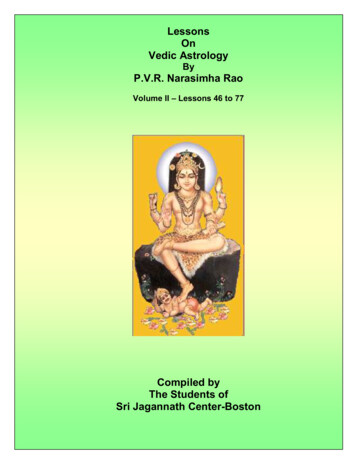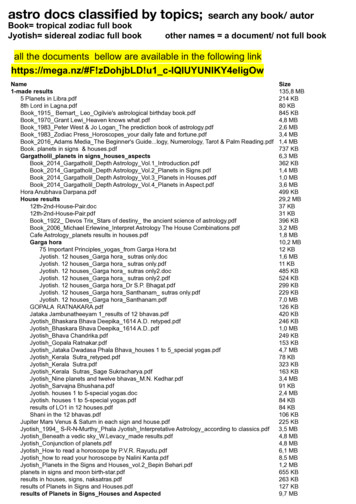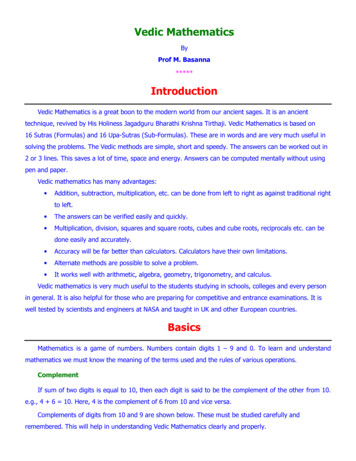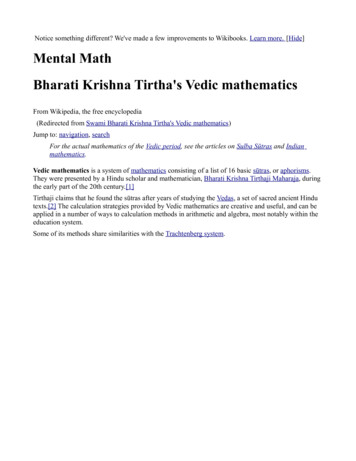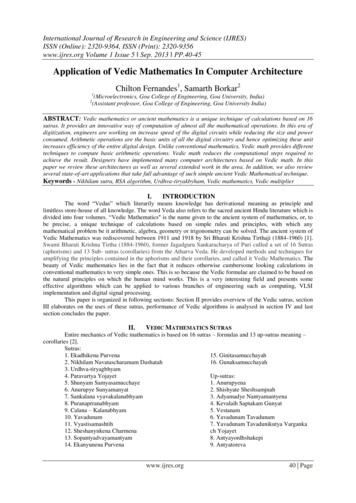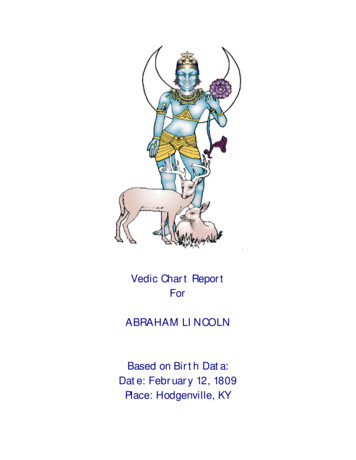
Transcription
Looking Back: An UpdateIn the last ten years since writing this book, my astrology studies and researchcontinued and my knowledge has been considerably refined. I have refined severalcalculations and concepts shared in this book, based on my studies, insights andexperimentation. I may try to edit this book or write a new book in future, reflectingthe refinements in knowledge. However, I think that the book may still be useful forclarifying some basic concepts and preparing the ground for advanced studies. So Iam sharing this book freely with all.Some of my researches are shared as free articles onhttp://www.VedicAstrologer.org/articlesMy writings on Jyotish are archived in the itings/messagesP.V.R. Narasimha RaoMarch 18, 2010
Vedic Astrology:An Integrated Approach P.V.R. Narasimha RaoFirst Published in 2000
Lord of the Universe, destroyer of demon Madhu, beacon of Yaducommunity, preceptor of Gita, giver of Knowledge, cowherd, one who isprayed by Shiva – the destroyer of Love God, beloved of Gopis, one whois filled with tempting charm, Krishna, born in Vrishni lineage, the FinalPreceptor with nothing beyond or after, a complete Incarnation, Vishnu,Govinda, leader of Gods — may He always bless me, Narasimha (Rao),who is bowed before Him.
DedicationThis book is humbly dedicated to the lotus feet of three great men fromwhom I learnt Jyotish:1. Sri P. Venkata SubrahmanyachalapathiRao (my father and my first guru),2. Dr. B. V. Raman (immortal author whorendered great yeoman’s service to Jyotish), and,3. Pt. Sanjay Rath (author, my guru and founderof “Sri Jagannath Vedic Centre”).My only qualification for writing this book, apart from great enthusiasmto share my little knowledge with others, is the little knowledge I gainedfrom the above three gurus. Whatever flows from my pen (or rathercomputer keyboard) is due to the knowledge and blessings I receivedfrom Mahavishnu and the above three great men. This book reallybelongs to them and not to me1.1But any mistakes in this book are mine.
About the authorP.V.R. Narasimha Rao is an engineer by profession. He did hisB.Tech in Electrical & Electronics Engineering at IndianInstitute of Technology, Madras (1987-1991). He did hismasters at Rice University, Houston, US (1991-1993). Heworks as a software engineer near Boston, USA.He is seriously interested in Jyotish and Sanskrit literature. Hisacademic record includes two diplomas equivalent toBachelor’s degree in Sanskrit at a young age: “SanskritaBhaashaa Kovida” diploma from Bharatiya Vidya Bhavan atan age of 10 and “Sanskrita Bhaashaa Visaarada” diploma,with distinction, from a board in Baroda at an age of 11. He isan ardent student of Jyotish and a designated Jyotish Guru at“Sri Jagannath Vedic Centre”.
PrefaceWith the Creator said to be one of its eighteen great preceptors, Jyotish or Vedicastrology is thought to be as old as this creation is. There are many excellent bookson Jyotish written in Sanskrit language by great Maharshis and brilliant scholars.Thanks to the yeoman service rendered by Dr. B.V. Raman and the efforts of otherIndian astrologers to follow him, today we have a fair amount of Jyotish literature inEnglish language too.Considering the wealth of Vedic astrology literature in Sanskrit and English, anotherbook may not really be needed. Even if another book is needed, there are manyerudite scholars who are better equipped than me to write. Nevertheless, I wanted,like a parrot that enthusiastically repeats the few words learnt by it, to share withfellow students the little knowledge I received from classics and from my gurus.In this book, I covered divisional charts, special ascendants, arudhas, argalas, yogas,ashtakavarga, avasthas, a few nakshatra dasas, a few rasi dasas, several techniquesof transit analysis, Tajaka analysis and a few miscellaneous topics.I tried to give prominence to special ascendants, divisional charts and arudhas,because contemporary literature doesn't seem to give them the kind of importancethat Sage Parasara gave. Understanding the primacy Parasara gave to all theseconcepts is a must for a renaissance in Vedic astrology.Unfortunately, some people think today that Parasara and Jaimini taught two totallydifferent approaches to astrology. When we talk about arudha padas, argalas, charakarakas, chara dasa and other rasi dasas, people think of them as “Jaimini astrology”.People even use terms like “Jaimini karakas” and “Jaimini dasas”. However, allthese concepts were covered by Parasara also (please read “Brihat Parasara HoraSastram”). The “Parasari vs Jaimini” distinction is based on unfortunatemisconceptions that we can do away with.In this book, I have de-emphasized these wrong distinctions and emphasized anintegrated approach – a holistic approach – that looks at Vedic astrology as a whole.I really think that this is the right approach.
In the part on dasas, I covered Vimsottari dasa and Ashtottari dasa, as they are themost commonly used nakshatra dasas. Kalachakra dasa was termed the “mostrespectable dasa” by Parasara and a discussion on dasas cannot be complete withoutit. In the galaxy of dasas, rasi dasas taught by Parasara and Jaimini have their ownplace and I covered two rasi dasas used for timing material success – LagnaKendradi Rasi dasa and Sudasa. I also covered Narayana dasa, which is the mostversatile rasi dasa taught by maharshis. For the spiritually inclined, I includedDrigdasa, which can help us in timing events in one’s spiritual evolution. Because ofthe importance of the topic of longevity, I covered two ayur dasas – Shoola dasa andNiryaana Shoola Dasa.In the part on transits, I covered the interpretation of transits based on the natalpositions of planets in rasi chart and divisional charts. I covered some techniquesbased on ashtakavarga and sodhya pindas. I also covered several techniques relatedto transits in nakshatras.In the part on Tajaka, I covered the casting of Tajaka annual, monthly and sixty-hourcharts, their interpretation, Tajaka yogas and three dasas used for timing events inTajaka charts. Some scholars may validly question why Tajaka system is beingcovered in a book on Vedic astrology. There are no references to it in the works ofParasara, Jaimini and other maharshis. The oldest reference to these techniques to befound in the works of a respected authority on Vedic astrology is in “TajakaNeelakanthi”, a work by Neelakantha who also wrote a celebrated commentary on“Jaimini Sutras”. His coverage of Tajaka system lends some authenticity to thesystem. One can only speculate whether Parasara talked about this system in partsthat are possibly missing today. I simply followed the precedent set by illustriousscholars of Vedic astrology, like Neelakantha and Dr. B.V. Raman.When we rely on finer techniques of Vedic astrology – such as divisional charts andspecial lagnas – for finer predictions, it is crucial to have an accurate birthtime. Thechapter “Impact of Birthtime Error” shows how to cope with birthtime inaccuracies.While I am upset with the dismissal of astrology by some critics as a ‘superstition’, Iam equally, if not more, upset with the irrational and unscientific attitude of someastrologers. In an effort to promote rational thinking in the astrological community, Iincluded a chapter on “Rational Thinking”.
A very brief introduction to some special topics such as remedial measures, mundaneastrology and muhurtas is provided in this book and it is hoped that interestedreaders will pursue these topics further by referring to other textbooks.Vedic astrology is considered a sacred subject and Maharshi Parasara warned usagainst sharing this knowledge with unworthy people. Ancient Sages laid downsome rules for the ethical behavior of a Vedic astrologer. I earnestly hope that all thereaders of this book will appreciate those rules. To that end, I added a chapter on“Ethical Behavior of a Jyotishi”.While no particular topic has been covered in great depth, most key fundamentals arecovered in this book. Most fundamental concepts and computations are clearlydefined with examples and their uses are briefly outlined. But I do not want to billthis as a comprehensive introduction for beginners. There are parts of this book thatcan be followed even by beginners, but an average beginner may find itoverwhelming in many places. For most part, this book is for intermediate levelstudents who already have a good background, but are in need of integrating andconsolidating their knowledge. However, there are some points in some places thatcan be appreciated only by advanced scholars. So I will not make any claims on whowill find this book useful. Rather than targeting readership with a specific level ofknowledge, I tried to write a more or less self-sufficient book that covers a widespectrum of topics. Beginners should read this book very carefully, and more thanonce, to completely understand various concepts. Though I have tried to maintainsome level of clarity, I squeezed in a lot of material and beginners should patientlyread, re-read and practice.Due to my background in engineering, I tried to adopt a style somewhat similar tothe one used in mathematics and physics textbooks. I tried to be concise and alwaysto the point. I gave plenty of examples and even some exercises. I hope that studentswill read the material and examples carefully and attempt the exercises sincerely. Ihope that the astrological community will accept this new style of astrology teaching.In this book, I did not try to steer clear of the controversies plaguing Vedic astrology.As my purpose in writing this book is to chronicle my broad understanding ofJyotish in a clear and concise fashion and to give clear guidance to fellow students, Istated my views clearly except in issues in which I do not have a firm opinion.
This book probably contains some fine knowledge, due to the blessings I receivedfrom my gurus, and some wrong knowledge as well, due to the limitations of myintelligence. Giving fine knowledge to unworthy students and feeding wrongknowledge to worthy students are both mistakes and I am aware that I may becommitting both. I beg for the forgiveness of my gurus, maharshis and gods.A free computer software program written by me called “Jagannatha Hora” isavailable for a free download on my website (http://www.VedicAstrologer.org). Itcan compute the positions of all planets, upagrahas, lagna, special lagnas, arudhapadas and ashtakavarga for twenty divisional charts. It supports several popularayanamsas. It gives Shadbalas, Vimsottari, Ashtottari and Kalachakra dasas and alsogives Tajaka annual charts, Patyayini dasa, Mudda dasa, Panchavargeeya Bala andSahams. Those who have a computer with a Microsoft operating system (Windows95 or later) can download and use this software.As I dedicated most of my free time in the last few years to astrology reading,research and writing, my wife Padmaja, my daughter Sriharini and my son Sriharishmade a personal sacrifice and co-operated with my astrological activities. I amthankful to them for their co-operation.I cannot possibly finish this preface without expressing my deep gratitude for myguru Pt. Sanjay Rath, who has been a constant source of enlightenment,encouragement and inspiration. I am eternally grateful to him. I express my gratitudeto all the elders and well-wishers whose blessings gave me the energy to finish thisbook. I hope that I will be forgiven for any mistakes and that I will continue toreceive their kind blessings.May Jupiter’s light shine on us,P.V.R. Narasimha Rao3 Baron Park Lane #13Burlington, MA 01803 (USA)e-mail: pvr108@yahoo.comJuly 15, 2000 (Guru Pournima)
ContentsPart 1: Chart Analysis . 11.2.3.4.5.6.7.8.9.10.11.12.13.14.15.Basic Concepts. 3Rasis . 21Planets . 28Upagrahas . 41Special Lagnas . 45Divisional Charts . 51Houses. 67Karakas . 79Arudha Padas . 85Aspects and Argalas. 100Yogas . 112Ashtakavarga . 145Interpreting Charts . 166Topics Related to Longevity. 180Strength of Planets and Rasis. 187Part 2: Dasa Analysis . 20716.17.18.19.20.21.22.23.24.Vimsottari Dasa . 209Ashtottari Dasa . 226Narayana Dasa . 231Lagna Kendradi Rasi Dasa . 259Sudasa . 263Drigdasa . 267Niryaana Shoola Dasa. 273Shoola Dasa . 281Kalachakra Dasa . 289Part 3: Transit Analysis. 31325.26.Transits and Natal References . 314Transits: Miscellaneous Topics . 346
Part 4: Tajaka Analysis . 36527.28.29.30.31.Tajaka Chart Basics . 367Techniques of Tajaka Charts . 374Tajaka Yogas . 386Annual Dasas . 396Sudarsana Chakra Dasa . 408Part 5: Special Topics . 41732.33.34.35.36.37.Impact of Birthtime Error . 420Rational Thinking . 441Remedial Measures. 450Mundane Astrology . 460Muhurta or Electional Astrology . 471Ethical Behavior of a Jyotishi. 482Part 6: Real-life Examples. 485
Part 1: Chart AnalysisSeveral important principles and techniques of chart analysisare explained in this part. This part forms the basis for the restof the book.Based on the positions of all the planets when a person is born,several charts are prepared. They go by the names – “rasi chart”and “divisional charts”. Based on the analysis of these charts,several conclusions can be drawn regarding the results that canbe given by different planets to the native. This part covers theanalysis and judgment of these charts.It can help if the reader has basic understanding and priorknowledge of Vedic or western astrology, but it is not reallyrequired. This part is intended to be self-sufficient. However,bear in mind that extra reading can only do good!
2Vedic Astrology: An Integrated Approach
Part 1: Chart Analysis31. Basic Concepts1.1What is astrologyPlanets are constantly in motion with respect to earth in the skies. The positions ofSun, Moon and some planets close to earth can give important clues about thefortunes of individual human beings and groups of human beings. That is the basicpremise of astrology. How exactly we can make guesses about the fortunes ofindividual human beings and groups of human beings based on the positions of thoseplanets in the skies is the question that we will attempt to answer in this book. Whileastrology is the subject that deals with this question, there are many theories andphilosophies in vogue and they are significantly different from each other.Sunsign astrology, for example, is based on categorizing people into 12 groups basedon the solar month of birth. Some people may be convinced, based on theirexperiences, that people born in the same month share certain qualities. It is,however, not very logical from a rational perspective – there are just too manypeople in this world, who are totally different from each other. So the month of one'sbirth is totally inadequate for guessing one's nature or fortune. Even the date and thehour of birth are not enough. We know that there are many twins in this world, whoare significantly different from each other!What we mentioned just now is, by the way, a very important question to beanswered – it is like an “acid test” for any astrological doctrine. It is a known factthat there are many twins in this world, who are significantly different from eachother and who lead totally different lives. Of course, some twins may have somecommon qualities between them, but the fact remains that several twins aresignificantly different. An astrological doctrine should be capable of explaining thisfact in order to be considered as a meaningful subject.Most astrological doctrines of the world fail this acid test. If an astrological doctrineassumes, like in the case of many popular astrological theories of the world, that twopersons born within a couple of hours in nearby towns will have the same fortune,
4Vedic Astrology: An Integrated Approachthen that doctrine is obviously lacking in completeness and inadequate for confidentuse in real-life. It fails the acid test of twins.1.2India's astrologyMaterialistically speaking, India may not be a rich country today, but India hasextremely rich cultural heritage. The depth of some of India's ancient knowledge(like astrology) is just amazing and it makes one wonder if the history of this greatcivilization is correctly represented in the pages of modern history. Astrology ofIndia is the most comprehensive and complete system of astrology available todayand it is the only one that comes close to answering the just mentioned “twinspuzzle”. India's astrology can explain how twins can be different. The principlesused in India's astrology are so sensitive to changes in birthtime that people bornwithin 1-2 minutes can be significantly different in some aspects and similar in someothers. This approach distinguishes between what a person truly is, what a personwants to be, what he thinks he is and what the world thinks he is. It has enoughparameters, tools, techniques and degrees of freedom to model the extremelycomplicated human life.This astrological approach is known in the world by many names. Early pioneers ofmodern Indian astrology, like Dr. B.V. Raman, called it “Hindu astrology”, becausethis system was first taught by ancient Hindu sages. However, some people do notlike this expression because “Hindu” is not a Sanskrit word. This word was latercoined by the western invaders from the name of a river flowing on the northwesternborder of India (river “Sindhu” or “Indus”). They used the word “Hindu” to describethe land and the people on the eastern side of this river.The religion practiced by a majority of Indians is known as “Hindu” religion today,but the fact is that there is no name for this religion in India's Sanskrit language, thelanguage in which most of the literature of this religion – and astrology – appeared!Most other religions are known by the name of their main propagator, but India'sancient religion had no single propagator or prophet. This religion consisted ofknowledge that revealed itself to spiritual masters of many generations. So there wasno name for this religion and the word “Hindu” coined by western invaders wasaccepted by the world. However, as already stressed, this word finds no place inSanskrit literature. Some people do not like using a non-Sanskrit word to describe
Part 1: Chart Analysis5India's astrology, considering that most of India's classical literature in astrologyappeared in Sanskrit.Later day authors came up with the name – “Vedic astrology". The word “Vedic”means “pertaining to Vedas". Vedas are the sacred scriptures of, what is knowntoday as, Hinduism and they are supposed to contain knowledge of all subjects.Moreover, astrology in particular is supposed to be a “Vedaanga” (which means alimb of Vedas). In particular, it is said to be the eye of the Vedas. So the name“Vedic astrology” is becoming popular these days. This author also suggests using“Vedic astrology” or “Jyotish” (meaning “science of light"). Jyotishi is a practitionerof Jyotish, i.e. a Vedic astrologer.1.31.3.1BasicsGrahas (planets)The words “planet” and “star” are used in a slightly different sense in astrology thanin astronomy. For example, Sun (a star) and Moon (a satellite of earth) are calledplanets in astrology, along with Mars etc. Basically, a graha or a planet is a body thathas considerable influence on the living beings on earth. Distant stars have negligibleinfluence on us, but Sun, Moon and planets in the solar system have a great influenceon our activities. So the word graha (or planet) is used to describe them.Seven planets are considered in Indian astrology. They are – Sun, Moon, Mars,Mercury, Jupiter, Venus and Saturn. In addition, two “chaayaa grahas” (shadowplanets) are considered in Indian astrology – Rahu and Ketu. These are also called“the north node” and “the south node” respectively (or the head and tail of dragon).Rahu and Ketu are not real planets; they are just some mathematical points.Apart from these 9 planets, there are 11 moving mathematical points known asUpagrahas (sub-planets or satellites). We also have lagna (ascendant), which is thepoint that rises on the eastern horizon as the earth rotates around itself. In addition,we have some mathematical points known as “special ascendants".1.3.2Rasis (signs)
6Vedic Astrology: An Integrated ApproachThe positions of all these planets, upagrahas, lagna and special lagnas in the zodiacare measured in degrees, minutes and seconds from the start of the zodiac (which is afixed point in the sky). These positions are measured as seen from earth and they arecalled “geocentric positions". For the positions (calculated in degrees, minutes andseconds) of planets, lagna, special lagnas and upagrahas, we also use the wordslongitude and sphuta. When watched from earth, the longitude of any planet in theskies can be from 0 0'0'' (0 degrees 0 minutes 0 seconds) to 359 59'59''. It should benoted that 0 0'0'' corresponds to the beginning of the zodiac. Many westernastrologers consider Sayana or tropical (moving) zodiac, whereas Nirayana orsidereal (fixed) zodiac is considered in Vedic astrology.The zodiac (sky) lasts 360 as mentioned above and it is divided into 12 equal parts.They are called “rasis” (signs). English names, Sanskrit names, two-letter symbolsand values of the start longitude and the end longitude (in degrees, minutes andseconds) of all twelve rasis are given in Table 1.Rasi ittariusCapricornAquariusPiscesTable 1: Definition of RasisSanskrit nameSymbolStartMeshaAr0 0'0''Vrishabha/VrishaTa30 0'0''MithunaGe60 0'0''Karkataka/KarkaCn90 0'0''SimhaLe120 0'0''KanyaVi150 0'0''ThulaLi180 0'0''VrischikaSc210 0'0''DhanusSg240 0'0''MakaraCp270 0'0''KumbhaAq300 0'0''MeenaPi330 0'0''End29 59'59''59 59'59''89 59'59''119 59'59''149 59'59''179 59'59''209 59'59''239 59'59''269 59'59''299 59'59''329 59'59''359 59'59''Notation: If a planet is at 221 37', then you can find from Table 1 that it is between210 0'0'' and 239 59'59''. So, that planet is in Scorpio (or Vrischika). Itsadvancement from the start of the rasi occupied by is 11 37'. Its position in thezodiac (221 37') is shown by some people by the notation 11 37' in Sc or simply 11Sc 37. This means “advanced by 11 37' from the start of Sc (Scorpio)". Some people
Part 1: Chart Analysis7show it as 7s 11 37'. This means “after completing 7 signs, advanced by 11 37' inthe 8th sign (which is Scorpio)".Exercise 1:Jupiter is at 94 19'. Mercury is at 5s 17 45'. Venus is at 25 Li 31. For each of theseplanets, find (a) the rasi occupied and (b) the advancement from the start of the rasioccupied.Each rasi again has many kinds of divisions and they are called “vargas". They willbe defined in detail later.1.3.3Bhavas (houses)Another important concept is “house” (Sanskrit name: bhava). In each chart, housescan be found with respect to several reference points and the reference points mostcommonly employed are lagna and special lagnas. Starting from the rasi occupied bythe selected reference point and proceeding in the regular order across the zodiac, weassociate each rasi with a house (first, second etc). Always the rasi containing thereference point chosen is the 1st house. Next rasi is the 2nd house. The rasi after thatis the 3rd house. We proceed until the 12th house like that. Just remember that whenwe encounter Pisces, we go to Aries after it. If no reference point is specified whenhouses are mentioned, it means that lagna is used as the reference.If, for example, horalagna is in Cn, first house with respect to horalagna is in Cn.Second house is in Le (see Table 1). Third house is in Vi. Ninth house is in Pi. Tenthhouse is in Ar. Eleventh house is in Ta. Twelfth house is in Ge.Exercise 2:(1) Lagna is in Cn, Sun is in Ar, Moon is in Ta and Mars is in Cp. Find the housesoccupied by Sun, Moon and Mars.(2) Repeat the exercise, taking Moon as the reference point when finding houses.Different houses stand for different matters. Looking at the rasis and housesoccupied by various planets, we can say a lot of things about the person. Howexactly this is done will become clear in coming chapters.
81.3.4Vedic Astrology: An Integrated ApproachChakras (charts)A “chart” (Sanskrit name: chakra) is prepared with the information of rasisoccupied by all planets. For preparing any chart, we need to first determine the rasisoccupied by all planets, upagrahas, lagna and special lagnas. In the visualrepresentation of a chart, there are 12 boxes (are some other visual areas) with eachrepresenting a rasi. All planets, upagrahas and lagnas are written in the boxescorresponding to the rasis they occupy.There are 3 popular ways of drawing charts in India: (1) South Indian style chartruled by Jupiter, (2) North Indian style diamond chart ruled by Venus and (3) EastIndian style Sun chart ruled by Sun. In this book, all the charts will be given informats (1) and (2).Out of the three chart formats, (1) and (3) are rasi-based and (2) is bhava-based. Inrasi-based chart drawing formats, a rasi is always at a fixed position. Ar is always inone particular position and Ta is in another position and so on. Planets, lagna etc areplaced in the box (or the visual area) representing the rasi occupied by it. In bhavabased chart drawing formats, a bhava (house) is always at a fixed position. Lagna(denoted by “Asc” for ascendant) is always in a particular visual area of the chart andthe 2nd, 3rd etc houses are in fixed positions.Example 1: Let us take Lord Sree Rama’s rasi chart. The rasis occupied by planetsand lagna are given below.Ar – Sun; Ta – Mercury; Ge – Ketu; Cn – Ascendant (lagna), Moon & Jupiter; Li –Saturn; Sg – Rahu; Cp – Mars; Pi – Venus.
Part 1: Chart Analysis9Figure 1: Indian Chart StylesRasi chart for the above data is drawn in South Indian, North Indian and East Indianformats in Figure 1. In the south Indian chart, notice the boxes containing Ar, Ta, Geetc. In this format, these rasis will always be in the same positions. The same holdsfor the east Indian format. The north Indian format is different. Note the boxco
scholars of Vedic astrology, like Neelakantha and Dr. B.V. Raman. When we rely on finer techniques of Vedic astrology – such as divisional charts and special lagnas – for finer predictions, it is crucial to have an accurate birthtime. The chapter “Impact of Birtht
